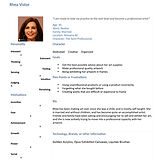Let's Connect:
UX/UI Portfolio
Opus Product App
Cultivating and providing access to product knowledge.
This app helps staff and customers navigate thousands of unique products available in-store and on-line. The vision is to create a space where artists could find and share their collective knowledge about their product experiences. The app is geared towards both knowledgeable users wanting to share, and new users curious about product features and benefits.
Scope: UX/UI program Final Project
Tools: XD
Role: Concept, Research, Analysis, Wireframes, Prototype
Context: Navigating all the products available at Opus is oftentimes overwhelming and daunting for staff members and shoppers alike.
Research - Understanding The Problem
By researching the market/competitors I determined what should be included, as users would be familiar with similar websites and have established expectations regarding what features would be available. After analyzing five similar company websites I discovered trends and identified useful traits, such as product sorting methods and the ability to add items to a wish-list.

To gather more information a Semi-Structured User Interview was conducted with several staff members. The resulting qualitative data provided insights into the nature of product knowledge and what could be improved. I learned that there were many pain points surrounding how information was transmitted, and that staff knowledge was a tremendous and somewhat untapped resource.

Analysis - Identifying Themes
Using an affinity diagram several themes were revealed. These themes were identified as pain points or features that were further reduced to findings, insights, and solutions. The scope of the project was getting too large to address all these themes, thus a MosCOW analysis prioritized these features and pain points to determine what was essential to the app.

Data Synthesis - Empathizing with Users
Along with their goals and user journeys, the following user segments were identified: new customer, returning customer, and staff. For each user a persona was crafted; this helped glean a better understanding of how they would use the app.
New User
-
Intimidated by selection
-
Unsure what is appropriate to meet needs

Returning Customer
-
Eager to share and view opinions about products that excite or disappoint
-
Frustrated when unable to access purchase history

Staff
-
Product knowledge is unfortunately lost with staff turnover
-
Stressful to answer unknown questions, often by interrupting other staff

As each of these users had somewhat different goals in mind, a final MosCOW analysis using these goals provided the essential features the app required.

Testing User Flow
A customer journey for each user was charted to generate insights surrounding how the app is experienced. Several missing details were brought to light, for example a shopping customer will be curious if an advertised discount was applied to their purchase. These details were included when listing the UI elements that would be required on each page.
Using cue-cards for a low-fidelity version of the app, I had users complete tasks by “tapping the screen”. This revealed user pain-points such as confusion surrounding purpose of the “like” button below the product description, and inability to find the main menu because of its unfamiliar format.

Finalizing Design In High-Fidelity
Using Adobe XD, a high-fidelity mock-up was created to incorporate the user interface elements and user-flow previously tested. Because the main menu had been difficult for users to navigate it was re-formatted to a more typical design, as those found during the competitor analysis for a more familiar experience.

Conclusion and Insights
Having ambiguous signifiers (such as the unfamiliar menu format, or the unlabelled thumbs up button below a product) do not provide the right constraints to lead to the desired actions. Displaying the vast menu options, specifically product categories, is overwhelming and cumbersome for users to navigate and requires minimization and organization; providing breadcrumb trails was important to remind users how they arrived at a product, and offered a convenient method to backtrack. While important to identify, having so many types of users verily increases the scope of the project.